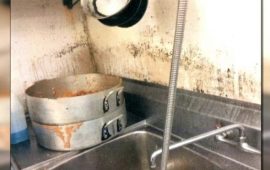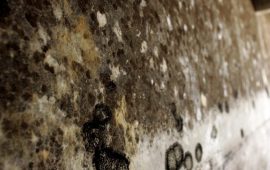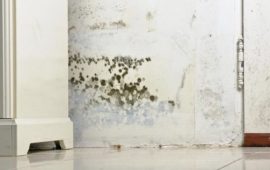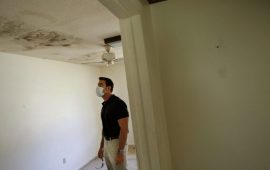Excessive mold growth brings more problems to your properties than ruined aesthetic. Failing in mold remediation efforts can result in exposure, health risks, and decreased property values due to the large growth of mold. If you find a large amount of mold growing on your properties, don’t panic. Here are the basic guidelines you should …
Mold
Mold is a kind of fungus that feeds on moisture and grows anyplace where it is damp or where there is decaying matter. Mold is also commonly known as Mildew. Mold by itself is not toxic, but it can become poisonous when it develops toxins, usually mycotoxins, and this is when it becomes toxic mold.
Mold is a fungus that is found everywhere, in all parts of the world, is characterized by green, orange, blue, or black patches around your home or workplace. Mold is found in the air indoors as well as outdoors. The airborne mold spores can come into homes through windows and doorways. They can also enter homes through ventilation systems, air conditioning ducts, heating systems, or any kind of system that involves intake of outdoor air.
Some of the signs of toxic mold around your home or workplace include:
- Stains on the ceilings and walls are a very common sign that indicates the presence of mold. These stains are usually blue, black, or green in color.
- If your home has a musty odor, or a lingering scent of urine, which cannot be explained, then it could be due to mold.
- Having allergies that refuse to go away despite treatment can be a sign of mold. Toxic Mold contains allergens that are known to cause allergies in people and also various other illnesses.
- Brown, orange, or green spots and specks are also a sign of mold infestation, especially around tiles and plumbing grouts.
There are also certain ways of handling and treating toxic mold once it has been identified, and early action is vital in order to avoid possible harm from the mold. Some of the steps that you should take include:
- Locate the mold: If you see any signs of mold in your home, toxic mold or otherwise, it is necessary to locate all the areas where any type of mold may be present. Places where mold is most likely to grow are wet basements, attics where there is a problem of a leaky roof, ceilings and walls due to leaky pipes, moist carpeting, behind and on wallpaper, and all kinds of wood products.
- Contain the mold: Once you have located the areas where mold grows, you need to contain the growth of toxic mold and stop it from spreading to unaffected areas. Mold needs moisture to grow, so you should try and stop its supply of moisture. Fix all leaky pipes and taps and ensure that there is no seepage of water behind your walls or in bathrooms.
- Kill and remove the mold: Toxic mold is a living organism and has to be killed to be destroyed. Spraying and fogging with mold destroying sprays is a good way to kill mold. Once the mold is destroyed, you have to remove the dead mold as even that can cause health problems. The area from where the mold is removed should be thoroughly dried and all supplies used to clean the toxic mold should be discarded.
Dealing with toxic mold problems can be difficult, and some people do not know enough about toxic mold to know whether they have been affected by this problem. However, this mold can affect your health and your environment, and in many cases can lead to legal recourse, so it is advisable to find out as much as possible.
This site aims to provide details on various areas of toxic mold, from the signs and symptoms to legal information. You can find articles such as:
This is a general overview of toxic mold, describing what it is, where it can be found, how it comes about, how it can be identified, what the effects might be, and what steps to take to minimize on toxic mold problems.
There are more than 100,000 types and species of mold, some of which are harmless, and some, which can cause serious health problems. The most common categories of mold are discussed in this article with a description of these types.
A very harmful and sometimes deadly type of toxic mold is known as Black Mold. This article looks at this type of mold, how it is formed, and how it can be detected and removed before causing harm.
The toxins produced by toxic mold can cause a lot of diseases, in animals and in humans. These illnesses can range from something as slight as a common cold, but in some cases, could even result in death. This article looks at some of the illnesses and problems that toxic mold can result in.
Legal Aspects of Mold Contamination
Over the years, many different laws have been passed, which protect the rights of people in case of mold contamination. This article looks at some of the legal aspects of mold contamination.
The number of private and commercial toxic mold claims is on the increase, and are often compared to asbestos-related claims in terms of their success. This has become a big issue, and successful claims so far have churned out figures in the multi-millions…
As with many other types of litigation, there are specialist lawyers available to deal with toxic mold claims, and this article looks at why and how it could be of benefit to go through a specialist lawyer in the event that you have been harmed through toxic mold.
This is an easy to reference listing of commonly asked questions, and you will be able to get easy access to these questions and answers in a reader friendly format.
About The Black Mold in Your Dishwasher: Is It Safe?
Besides the bathroom sink, the dishwasher in the kitchen also has the potential of being infested by fungus or black mold. It is actually the same case, the humidity and the leaking water are the perfect combinations for any mold growth. This is why you should not be surprised if you see black mold in …
Molds and The Musty Smell in Your House
Molds are filamentous fungi that can live both outside and inside of a building. A musty smell means they are spreading around (USDA report). Besides the smell, other sign may also appear, such as suffering allergic symptoms and water problem (leaks). But, how if the house smells musty but no mold found in there? This …
This Is How to Remove Mold Using Lysol
Molds can grow anywhere such as bathroom, kitchen, and even on fabrics (clothes and bedding set). The annoying fact is this fungus can return easily after the removal, especially if you do not do a regular and thorough treatment. In the house, following are the common places where molds grow and spread. Bathroom. You use …
The Effects of Breathing in Mold
Molds can cling to almost any item easily. With the support of warmth which can be a trigger of a high humidity level, the molds will start to grow and spread. The growth of the mold would be more rapid if they live on a material that is moist and consists of cellulose (they need …




